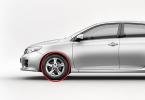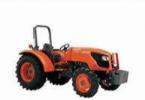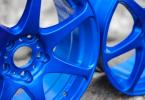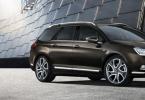SsangYong Motor Company is a South Korean auto (passenger car) manufacturer headquartered in Seoul. Sang Yong in Russian means "two dragons", the company ranks third among Korean automakers in terms of the number of cars sold.
The official date of foundation of the history of the SsangYong company is considered to be October 1954, at the time of its appearance the company received the name Hadonghwan Motor Company. The first products of the automaker were licensed Willys (army off-road vehicles) supplied to the South Korean army. Thanks to the constant orders of the military, the Sanyeng company (there are still transcriptions of Sang Yong, Sangeng or Ssangyong) quickly achieved financial success and gradually expanded the range of manufactured equipment. In the 60-70s, the company managed to launch the production of trucks, buses and special-purpose vehicles.
In 1967, through partnership with Shinjin jeep Motor Co., Ltd. contracts are concluded for the supply of buses to Vietnam.
1974, Hadonghwan Motor Company becomes co-owner of Motor Shinjin jeep.
In 1976 the company changes its name to Dong-A Motor. Development of new off-road vehicles designed to carry 4-6 people using diesel engines is underway.
In 1979, a new car assembly plant was opened in the city of Pyeongtek.
1983 purchase of the Korando trademark from Geohwa Co., Ltd followed by the takeover of Geohwa.
In 1986, Dong-A Motor came under the control of Ssangyong Business Group, and in 1988 it received its current name SsangYong Motor. The Korando Family appears in the lineup - created on the platform of the Japanese Isuzu Trooper.
In 1991, SsangYong enterprises entered into a technical cooperation agreement with Mercedes-Benz AG (development of new gasoline engines).
In 1993 Mercedes-Benz AG became one of the main shareholders of Ssang Yong Motors, the second co-owner is the Chinese company SAIC Motor. Mercedes AG and Sanyeng Motors join the technical union. At this point in the history of Sang Yong, all cars are produced under the supervision of Mercedes-Benz representatives.
SsangYong cars use engines, gearboxes and many of the design solutions and technologies of the German automotive giant. The launch of the SsangYong Musso SUV.
In 1995, sales of Korean Sang Yong cars began in Europe, the Istana model became the first-born - an exact copy of the Mercedes-Benz MB 100 minibus, produced from 1988 to 1995.
In 1996, a new Korando appears, the company certifies its products according to international ISO standards.
In 1997, the Chairman executive sedan, based on the Mercedes-Benz W124, appears in the Sanyeng lineup.
In 1998, the company came under the control of the Daewoo Group, but not for long. Two years later, in 2000, Ssang Yong was again an independent structure.
In 2001, the production of the off-road novelty Rexton starts.
In 2002, the SsangYong Musso Sports pickup was launched into serial production.
2003 saw the introduction of the new generation Chairman sedan and Rodius minivan with a controversial design.
The SsangYong Kyron SUV debuts in 2005.
In 2006, another novelty by Sang Yong Actyon.
In 2008, the premiere show of the first crossover in the SsangYong lineup - the C200 Concept (only two years later, after changing the name to Korando, the car will reach buyers). In the same year, the company's management declares bankruptcy, after the restructuring, the company was put up for sale. On August 12, 2012 SsangYong Motor was acquired by the Indian concern Mahindra & Mahindra Limited.
The production of Sanyeng SUVs for Russian buyers is carried out at the Sollers factories in Naberezhnye Chelny and Vladivostok.
Today in Russia and the CIS countries Ssang Yong cars are in steady demand. The following models of the Korean-Indian manufacturer are available in Russian car dealerships: Actyon, Kyron, Rexton and Actyon Sport pickup.
Korando (twin of the Russian Actyon), Actyon and Actyon Sports, New Actyon Sports, New Kyron and Rexton II are available to Ukrainian buyers. Perhaps in the near future, the SsangYong executive sedans will be added to the Korean SUVs sold in the post-Soviet space.
The vehicles of the leading brand in Korea, in existence since 1954, are renowned for their advanced design and excellent performance, thanks to the company's strong engineering team.
In the 1980s, the company entered the era of 4WD by independently developing the Musso and Korando models. Since 2000, SsangYong has established itself as a leading manufacturer of SUVs with a complete line of crossovers and SUVs including Rexton, Korando, Korando Sports, Tivoli and XLVs.
1983 KORANDO

2017 KORANDO
Opening new horizons in the luxury sedan market, Chairman has become the country's leading car in its class. Recently, an updated Chairman W also became available. It is the first Korean luxury car with a 5000cc V8 engine and 7-speed automatic transmission. Currently, Chairman W is the flagship of the Korean market and competes with the world's leading luxury cars.
The eco-friendly Korando compact SUV is SsangYong Motor's first front-wheel drive vehicle with a monocoque body. Korando, which marks the beginning of a new milestone for the entire line of the company, is the first Korean brand to be known for so long in the global SUV market.
SsangYong Motor has contributed to the development of environmentally friendly diesel technology based on an advanced battery-powered engine. The company has focused on strengthening its competitive edge with the compact, eco-friendly eXDi200 Euro 5 engines and is developing a new line of engines that will comply with the Euro 6 standard.
With its global customer-centric policy, SsangYong Motor is increasingly expanding its presence in the global market. SsangYong Motor SUVs are sold in 1,645 retail outlets in over 126 countries.
Moreover, the company is strengthening its presence on the global stage by opening representative offices in key markets. As confirmation of its intentions, the company has opened headquarters as well as distribution centers in strategically important locations in Europe that set the tone for the modern automotive industry.
To ensure sustainable growth, SsangYong Motor is focusing not only on mature and mature markets, but also on emerging markets in Central America and Eastern Europe, and even plans to expand into India and China, the largest automotive markets in the world.
In pursuit of only the best results, SsangYong Motor is committed to developing new designs and technologies, enhancing driving performance and reflecting the company's unique identity. In addition, by focusing on a strong SUV lineup, SsangYong will be able to further strengthen its position in this market through technical cooperation with Mahindra & Mahindra, which also specializes in the production of SUVs.
* In Russia, the model is called SsangYong Actyon.
Ha Dong-hwan Motor Co., Ltd is established in Korea.
The company becomes Korea's first bus exporter to Vietnam.
Beginning of technical cooperation with the American Motors Corporation joint venture, pioneer of Jeep compact SUVs, and Shinjin Jeep Motor Co., Ltd.
Jointly with AMC and Shinjin jeep Motor Co., Ltd. the development of the first off-road vehicles in Korea - SsangYong Korando, which was a licensed copy of the Jeep CJ-7, with a hard and soft top. The name Korando is an abbreviation of the phrase "Korea Can Do".
The production of special-purpose vehicles (snowblowers, dump trucks with trailers, etc.) has been launched.
Corporation name change to Dong-A Motor Co., Ltd.
Diesel models of off-road vehicles for 4.5 and 6 seats have been developed.
Completed construction of an automobile plant in Pyeongtaek, Korea.
The company became the official supplier of the South Korean national defense industry.
Dong-A Motor acquires the KORANDO trademark from Geohwa Co., Ltd (formerly Shinjin Jeep Motor). The second generation of the Korando SUV is launched.
Dong-A Motor acquires a majority stake in Geohwa.
Geohwa's manufacturing facility from Pusan has been relocated to Pyeongtek.
Exports Korando to Japan.
SsangYong Group takes over the management of the company.
R&D center established at the Pyeongtek plant, Korea.
SsangYong Group acquired the British company PANTHER CAR.
Start of Korando export to Northern Europe.
Company name changed to SsangYong Motor.
The Korando Family extended wheelbase SUVs are on sale.
The logo has changed.
A strategic alliance has been concluded with Mercedes-Benz AG, part of the Daimler-Benz AG concern, with the aim of creating small-sized commercial vehicles.
Panther Kallista classic sports cars are now exported.
A strategic cooperation agreement was signed with Mercedes-Benz AG on the development of gasoline engines.
Production of the SsangYong Musso, an all-wheel drive SUV, kicks off.
A deal has been concluded to sell 5% of SsangYong shares to Mercedes-Benz AG.
An agreement was signed with Mercedes-Benz AG for the joint development of diesel engines.
Completed construction of the engine manufacturing plant in Changwon, Korea.
Launch of the second generation of the Korando family into production.
The first Istana small commercial vehicles roll off the assembly line.
SsangYong is the first Korean car manufacturer to receive ISO certification.
Third generation SsangYong Korando introduced.
The Chairman is introduced to the Korean market.
Merger with Daewoo Group.
The updated SsangYong Musso is presented.
The seven-seater version of the SsangYong Musso model is presented.
A major internal corporate reorganization was carried out.
SsangYong releases Chairman CM500 update.
End of cooperation with Daewoo Group.
The Korando brand receives the "Energy Winner 2001" award founded by the non-governmental organization "Consumers of Korea" and supported by the Ministry of Commerce, Industry and Energy, Ministry of Environment.
In Korea, the updated Musso, Korando and Istana are presented.
For the third year in a row, Musso becomes the leader in the SUV segment with the Brand Power Awards.
500,000th engine produced at the Changwon plant.
Rexton, the premium SUV, goes on sale.
The SsangYong Musso Sports functional pickup truck is released.
SsangYong is recognized as the best company for customer satisfaction.
SsangYong won the Best Enterprise Management Company award.
SsangYong received the "Prime Minister" Award for Promotion Technology.
SsangYong Kyron is a South Korean crossover. The car has been produced since 2005. Initially, for the Russian market, Chiron was assembled in Naberezhnye Chelny, and since December 2009 - in Vladivostok (this was the first model of the new enterprise "Sollers - Far East").
It is not by chance that Kyron got its "off-road roots", because working with off-road vehicles, one might say, is in the blood of SsangYong. Even during the war between North and South Korea, the Donghwan Motor company appeared, which was engaged in the production of military off-road vehicles. A couple of years later, the company changed its name to SsangYong and continued to engage in the automotive industry, but this time civil. Gradually, she began to buy up other Korean companies, creating an automobile monopoly. The first civilian SUV of the SsangYong concern was the Korando Family, which had. This detail was subsequently adopted by Kyron.
Partly the predecessor of Kyron, designed by Ken Greenlee (who also designed Kyron). In addition, a licensed Mercedes-Benz engine was installed on Musso for the first time, which later migrated to Kyron. However, Musso is a full-fledged SUV, and Chiron was created primarily as an urban crossover. A platform for it, which has been produced since 2001 (the Rexton itself is built on the basis of the Mercedes-Benz M-class).
A year after Kyron's debut, the SsangYong Actyon went on sale. These two cars are classmates and differ only in body and interior design. SsangYong Actyon was produced from 2006 to 2011, but its production was closed due to increased demand for Chiron. However, Kyron was not destined to remain alone. In the same year, 2011, at the facilities of the Far East plant "Sollers" the production of Kyron's brother in the class - the updated SsangYong New Actyon - was resumed.

Technical features
The car body has a frame structure, which provides many advantages. The frame is made of high-strength metal, adds weight to the car, thereby eliminating vibrations inside the cabin while driving. In addition, in the event of a collision, the body is seriously protected from deformation.
Another plus to the off-road performance of the car is the design of the fenders. SsangYong engineers managed to design them in such a way that even when driving through mud, Kyron's glasses are reliably protected and remain clean.
In the Russian market, a 2.3-liter gasoline engine is offered for the crossover, as well as a 2.0-liter turbodiesel - the special pride of the "Korean" inherited from Mercedes. In other markets, the diesel Kyron is also found in a 2.7-liter version.
Ken Greenlee, Kyron's designer, admitted that when creating the first version of the car, he was too carried away by the culture of the Middle Ages. As a result, the interior received a lot of roundness in the design of the devices, and the handle of the "handbrake" was generally similar to the hilt of a sword. Such a non-standard appearance of Kyron seemed to the company's marketers too provocative, and she was "reassured" by means of restyling.
Initially, Chiron was assembled at a plant in Naberezhnye Chelny, where Oka's car was produced at the same time.
In any, even the richest Kyron configuration, there is no head unit. Its installation will have to be dealt with by the dealer or the owner on their own.

Pros and cons
In fact, the closest rival of the Korean crossover can be considered the Suzuki Grand Vitara. With similar dimensions, Chiron boasts a more spacious interior and the ability to adjust the steering wheel for departure (the absence of this adjustment on the Grand Vitara is a paradox for which there is no explanation).
Another plus in Kyron's piggy bank is a large trunk volume, which can be increased by folding the rear seats (up to 1,085 liters).
Among the minuses, we can highlight the lack of assistance mode on Chiron when descending from the mountain, which is a characteristic feature of any modern SUV.
Finally, a completely unexpected drawback is the cost of car maintenance in Russia. Despite its Korean origin, prices from official dealers are not at all "Korean".
In general, SsangYong Kyron and Suzuki Grand Vitara are cars of different specifics. Chiron offers the owner confident traction at low revs (in the diesel version), comfort and reliability even off-road. In turn, Vitara is a more nimble car, it shakes and you feel the passage of every bump, which adds drive during a country trip.
The target audience
SsangYong Kyron – this is the choice of lovers of comfortable movement around the city and regular picnics in the countryside. Moderately powerful, reliable and roomy, it is perfect for a small family. In addition, do not forget that Kyron is the flagship of the SsangYong line for a very reasonable price.
Awards and numbers
In 2006, the British magazine 4x4 included the SsangYong Kyron in the list of the best SUVs of the year. The car was in 6th position with a result of 29 points (for comparison, the winner of the Jeep Commander - 39).
In 2007, Chiron was included in the list of contenders for the title of "Car of the Year" in Europe, but he did not reach the finals, and even more so, until the victory.
On March 25, 2010, the Sollers - Far East plant solemnly celebrated the thousandth Kyron that rolled off the assembly line. In total, 1548 SsangYong Kyron cars were sold in Russia in 2010.
In Russia, SsangYong Kyron was received quite warmly. Against the background of competitors, it stood out for its very moderate cost. And assembly at the Sollers factories in Naberezhnye Chelny (since the end of 2006) and Vladivostok (since 2010) only strengthened its success in the market. Customers were impressed by the powerful off-road potential of the "Korean". Four-wheel drive is implemented according to the Part Time system, without an center differential. Under normal driving conditions, the torque drives the rear wheels (2H mode), and on off-road or slippery surfaces, the front axle is rigidly connected (4H mode). It can be used at speeds up to 80 km / h. Off the road, a downshift (4L mode) and a rear limited-slip differential help out.
The finishing materials are of good quality, the assembly is neat. But interior design is not for everybody.
The Russian Kyrons are generously equipped. In the basic Original version, the all-wheel drive SUV (there are also rear-wheel drive versions) comes with ABS and EBD, air conditioning, two airbags, foglights and heated front seats, electric windows and mirrors, and 16-inch alloy wheels. The Comfort version is complemented by climate control, a 2DIN audio system with CD / MP3 player and roof rails. The expensive versions of Comfort +, Elegance and Luxury were equipped with an ESP stabilization system and four airbags. And the richest versions of Elegance and Luxury sport a leather interior and electrically adjustable front seats. The Luxury also has a sunroof and a heated rear sofa.
Engine
Chassis and body
In the front spring suspension, both upper and lower ball joints (1300 rubles each) are weak, which sometimes did not take care of even 10 thousand km. Reinforced parts serve up to 50 thousand km. After two or three years, as a rule, the rear springs sag (2200 rubles each) - the front springs from Rexton or the rear ones from the Chevy-Niva fit. There were cases of rear axle breakage (68,000 rubles) after 50,000 km. In the steering, tips are short-lived (1300 rubles each). The rail itself is considered non-repairable. But unofficials can tighten the washers and replace the seals for 3000 rubles. - enough for 20-30 thousand km. And by 50 thousand km, the steering shaft cardan is loosened (from 3500 rubles). The vacuum brake booster refused, but after 2009 a valve with a filter was installed in the system, and the problem went away.
The body and its paintwork are strong. But on cars produced in 2008-2009, a crack appeared on the left front fender due to weakening of the metal in the welding zone with the bracket on which the battery is installed. The folding mechanism of the side mirrors often fails (from 7500 rubles). The seat heating "spiral" burns out. Approximately once a month, low beam lamps (60-200 rubles) and dimensions are lit.
From debut to restyling
Just two years after the release of the model, in 2007, the Koreans modernized the SsangYong Kyron. However, this is not surprising. The design of the debutant was perceived too defiantly. On the updated car, three horizontal slots under the headlights were abolished, and the radiator grille was enlarged and decorated in the style of Mercedes-Benz. Installed a different bumper. Round foglights gave way to rectangular-oblong ones, and instead of taillights in the form of knightly shields, more traditional ones appeared. The salon remained practically unchanged - only the center console was trimmed with carbon-like inserts. But in the range of engines there appeared a petrol "four" of 2.3 liters (150 hp) and a 4-band automatic transmission.
Verdict
editor:- When buying a used Kyron, I wish you got a technically sound and problem-free copy in the future, since there is a high probability of buying a pig in a poke. You understand - a lottery. Therefore, you need to protect yourself from troubles as much as possible. For which we recommend a complete diagnosis. And you shouldn't contact the official service. Statistics show that the most competent masters and diagnosticians of SsangYong work at specialized service stations. And there is no need to be afraid of repair or replacement of units by the first owner. The main thing is that the work is done with high quality, because the shell does not hit the same funnel twice.
I managed to visit the assembly shop of the Sollers - Far East plant. I went and looked, took pictures of how cars are assembled. The main purpose of the visit was this SsangYong New Actyon, the car put into serial production at the Primorsky plant.
There were a lot of people, foreign guests, the press, the management of the plant and many others gathered here.
In order not to lose anyone, everyone was assigned to groups and assigned a personal guide.
1.
Photography was my goal, so I immediately fought off my group. The guide talked a lot about each stage of the assembly, answered any questions, I regret that I left the group, because. photo captions are nowhere to be found%)
New line:
2.
Body without filling
3.
waiting in line
4.
Such mini-tractors deliver all kinds of spare parts throughout the plant.
5.
Many girls were seen among the staff
6.
The inscription on the plates characterizes the workflow
7.
apparently they are engaged in the subassembly of the engine compartment
8.
Wheels ready to take their place
9.
Sobsno installation
10.
11.
What this computer is responsible for, I have not figured out
12.
Twisting something there
13.
New conveyor
14.
Hundreds of meters of wires and a wide variety of electrical accessories
15.
This guy is driving the lift
16.
And this one puts the engine in the car
17.
18.
19.
20.
21.
Human labor
22.
Using a lift, workers install the body
23.
and fix it
24.
Foreign guests carefully examine the assembly process
25.
26.
Assembled cars are lined up in a very bright workshop, powerful lamps make it possible to see if there are scratches, chips and any other jambs on the paint
27.
The last stage.Auto prepares for the computer diagnostics box
28.
Diagnostics
29.
Fully finished cars
30.
Well, that's all I saw in production.
—
At the end of the excursion, everyone was finally gathered in a tight ring around the new car covered with a white canvas. Alexander Vladimirovich Korneichuk, General Director of SOLLERS-Dalniy Vostok, held the speech.
31.
At the end of the solemn performance, the guests were presented with a light show. The rays painted the car in different colors, designed all kinds of images on it, beautifully ..
32.
After that, the car was given to be torn apart by everyone.
33.
NEW Actyon is the first SsangYong crossover with a monocoque body and an all-wheel drive system
34.
This is already the fifth model, the production of which has been established at the plant in Vladivostok, along with Rexton, Kyron, Actyon, Actyon Sports.
35.
Sales of the new NEW Actyon model will start in February, with the first cars to appear at dealers in the Far East.
36.
In Russia, the NEW Actyon will be available with two versions of a 175 hp diesel engine. and 149 hp. In addition, NEW Actyon is equipped with a 6-speed manual or 6-speed automatic transmission with manual shift function.
Prices for the basic version of the SsangYong NEW Actyon start at 799 thousand rubles with a 149 hp engine, manual transmission and front-wheel drive.
The most popular, as expected, modification with a 149 hp engine, automatic transmission and all-wheel drive is available from 939 thousand rubles.



